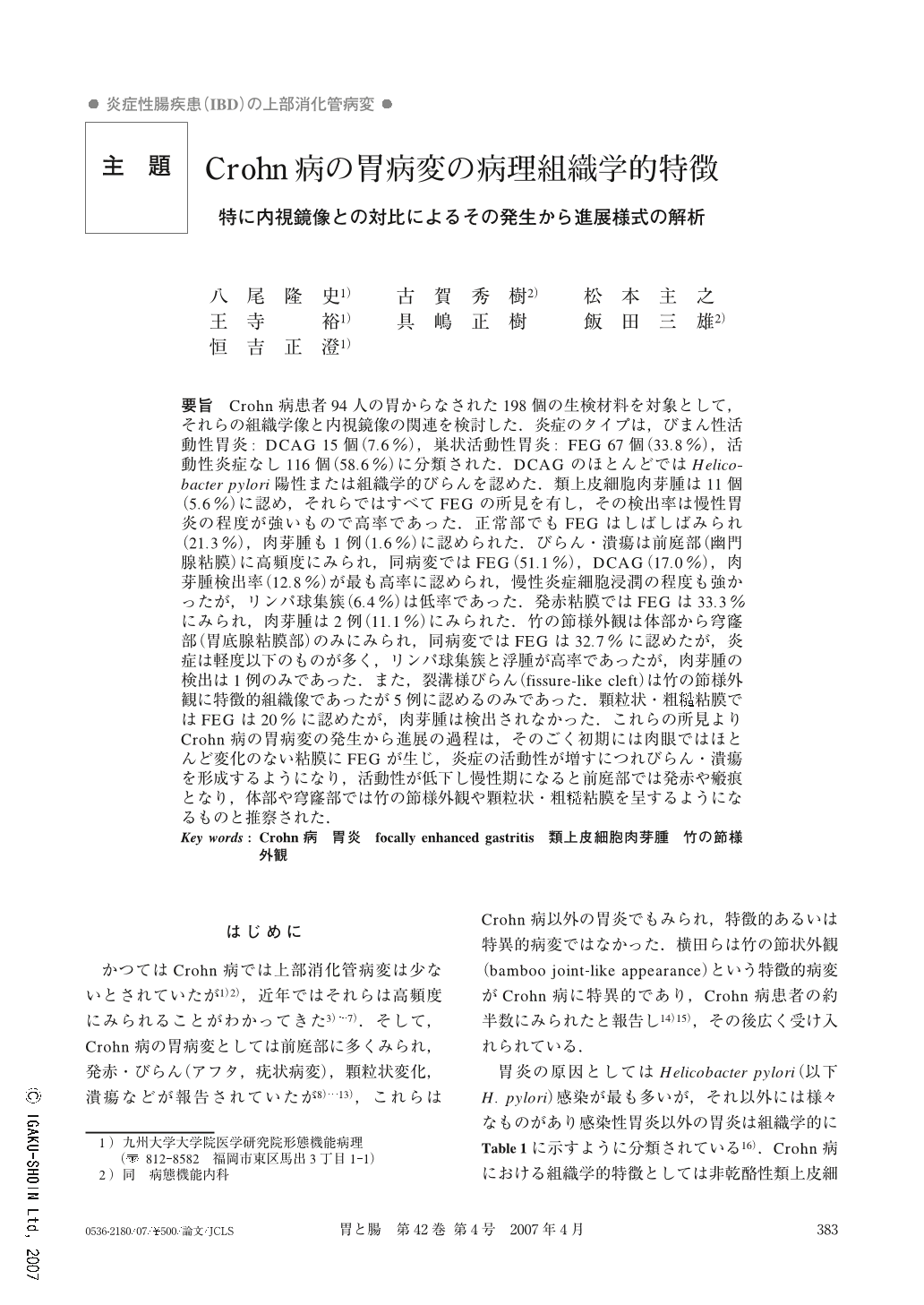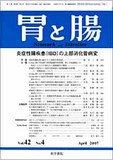Japanese
English
- 有料閲覧
- Abstract 文献概要
- 1ページ目 Look Inside
- 参考文献 Reference
- サイト内被引用 Cited by
要旨 Crohn病患者94人の胃からなされた198個の生検材料を対象として,それらの組織学像と内視鏡像の関連を検討した.炎症のタイプは,びまん性活動性胃炎:DCAG 15個(7.6%),巣状活動性胃炎:FEG 67個(33.8%),活動性炎症なし116個(58.6%)に分類された.DCAGのほとんどではHelicobacter pylori陽性または組織学的びらんを認めた.類上皮細胞肉芽腫は11個(5.6%)に認め,それらではすべてFEGの所見を有し,その検出率は慢性胃炎の程度が強いもので高率であった.正常部でもFEGはしばしばみられ(21.3%),肉芽腫も1例(1.6%)に認められた.びらん・潰瘍は前庭部(幽門腺粘膜)に高頻度にみられ,同病変ではFEG(51.1%),DCAG(17.0%),肉芽腫検出率(12.8%)が最も高率に認められ,慢性炎症細胞浸潤の程度も強かったが,リンパ球集簇(6.4%)は低率であった.発赤粘膜ではFEGは33.3%にみられ,肉芽腫は2例(11.1%)にみられた.竹の節様外観は体部から穹窿部(胃底腺粘膜部)のみにみられ,同病変ではFEGは32.7%に認めたが,炎症は軽度以下のものが多く,リンパ球集簇と浮腫が高率であったが,肉芽腫の検出は1例のみであった.また,裂溝様びらん(fissure-like cleft)は竹の節様外観に特徴的組織像であったが5例に認めるのみであった.顆粒状・粗ぞう粘膜ではFEGは20%に認めたが,肉芽腫は検出されなかった.これらの所見よりCrohn病の胃病変の発生から進展の過程は,そのごく初期には肉眼ではほとんど変化のない粘膜にFEGが生じ,炎症の活動性が増すにつれびらん・潰瘍を形成するようになり,活動性が低下し慢性期になると前庭部では発赤や瘢痕となり,体部や穹窿部では竹の節様外観や顆粒状・粗ぞう粘膜を呈するようになるものと推察された.
The correlation between histological and endoscopical features was evaluated by using 198 gastric biopsy specimens from 94 patients of Crohn's disease. The inflammatory types were classified into three ; diffuse chronic active gastritis (DCAG) : 15 lesions (7.6%), focally enhanced gastritis (FEG) : 67 lesions (33.8%) and no active inflammation : 116 lesions (58.6%). Most lesions with DCAG were accompanied by Helicobacter pylori infection or histological erosions. Epithelioid cell granulomas were identified in 11 lesions (5.6%), and the inflammatory type of all 11 lesions with granulomas was FEG. Granulomas were more frequently seen in those with moderate to severe inflammation than those with no or only mild inflammation.
FEG (21.3%) and granulomas (1.6%) were also seen even in the specimens with endoscopically normal mucosa. Endoscopical erosions/ulcers were frequently seen in the antrum (antral mucosa). In the specimens from erosions/ulcers, FEG (51.1%), DCAG (17.0%) and granulomas (12.8%) were most frequently recognized and inflammation was more prominent than in other lesions, but lymphoid aggregates were infrequent (6.4%). In the specimens from reddish mucosa, FEG (33.3%) and granulomas (11.1%) were occasionally recognized. Bamboo-joint-like appearance (BJA) was only seen in the gastric body to the cardia. In the specimen from it, inflammation is relatively mild and granulomas were seen only in one lesion although FEG (32.7%) was occasionally seen. In addition, edema and lymphoid aggregates were frequently seen in those from BJA. Fissure-like clefts or erosions were a characteristic histological feature of BJA, but it was only recognized in 5 lesions. In the specimens from granular/rough mucosa, FEG (20.0%) was occasionally seen, but no granuloma was identified.
From the above findings, FEG is considered to be an incipient histological change in Crohn's disease and it is present even in endoscopically normal mucosa. During progression of inflammation, it develops into erosions/ulcers occasionally with granulomas. At the resolving to healed phase, reddish mucosa is formed in the antrum and BJA or granular/rough mucosa is formed in the body to the cardia.

Copyright © 2007, Igaku-Shoin Ltd. All rights reserved.


